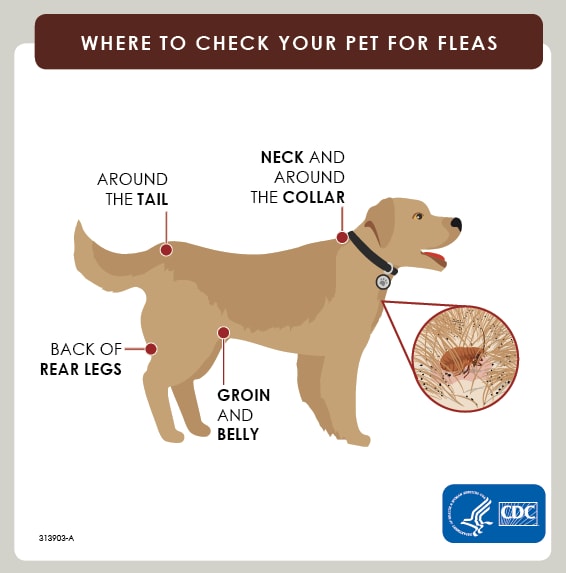Key points
- The best way to prevent fleas on people is to keep pets free of fleas.
- Most fleas in the United States prefer to feed on animals, however, people are sometimes bitten when they share space or have contact with a flea-infested animal.

Prevention tips
Preventing fleas on your pets
Dogs and cats are very susceptible to fleas, but they can be protected. To prevent fleas on your pet:
- Limit the amount of time your pet spends outdoors.
- Limit contact with wild and stray animals.
- Bathe and brush pets regularly.
- Check for fleas regularly.
- Fleas prefer warmer and more humid months, but if there is an animal to feed on, fleas can survive year-round.
- Talk to your veterinarian about flea control products that are right for your pet.
- Treat pets for fleas year-round in order to kill adult fleas and prevent new ones from hatching.
- Always follow product instructions.
- Treat pets for fleas year-round in order to kill adult fleas and prevent new ones from hatching.
- If you find a flea on your pet or in your home, learn how to get rid of fleas right away to avoid further infestation.

Preventing flea bites
- Keep pets free of fleas (see tips below).
- Use Environmental Protection Agency (EPA)-registered insect repellents containing DEET, picaridin, IR3535, Oil of Lemon Eucalyptus (OLE), para-menthane-diol (PMD), or 2-undecanone. EPA's helpful search tool can help you find the product that best suits your needs. Always follow product instructions. Do not use products containing OLE or PMD on children under 3 years old.
- Cover skin with long-sleeve clothing and pants to minimize exposure to bites. Flea bites often occur on the lower legs and feet, protect these areas with long socks and pants.
- Treat clothing and gear with products containing 0.5% permethrin. Permethrin can be used to treat boots, clothing and camping gear and remain protective through several washings. Alternatively, you can buy permethrin-treated clothing and gear.
- Do not feed or pet stray or wild animals.
- Always wear gloves if you are handling sick or dead animals.
Additional plague prevention tips are available.
Keeping fleas out of the home and yard
It's easier to keep fleas out of your home than it is to get rid of them. Fleas can live in carpets, bedding, and other surfaces in the home that pets frequent. To prevent an infestation:
- Sweep or vacuum well and often. Vacuum your carpets and rugs as well as cushions on chairs and sofas. Be sure to empty the vacuum bag outside when finished.
- Clean bedding, especially pet bedding, frequently with soap and water.
In the yard, fleas prefer habitats with shade, as they cannot tolerate the sun for long periods. To prevent flea infestations, make your yard as unattractive to fleas as possible by:
- Mowing frequently. Mowing exposes the soil to the sun, which fleas try to avoid.
- Avoiding over-watering. Fleas thrive in humid environments so keeping the yard dry makes it less inviting.
- Treating dog runs with insecticides to make it less prone to fleas.
- Raking thoroughly to remove any debris. This increases flea exposure to potential insecticides and removes any shaded and humid breeding places.
- Keep rodents and animals (e.g. opossums) away from your home:
- Store food, including pet food, in tight sealing containers.
- Remove brush, rock piles, junk, and cluttered firewood outside of your home.
- Seal up holes in your home where rodents can enter.
- Keep tight lids on compost and trash cans.
- The CDC's rodents website offers helpful suggestions on rodent control during and after a rodent infestation.
- Store food, including pet food, in tight sealing containers.
Additionally, wild and stray animals commonly carry fleas. Put away pet food to discourage stray animals from hanging around your home and limit your pet's contact with wild and stray animals.
